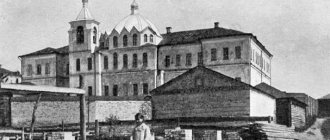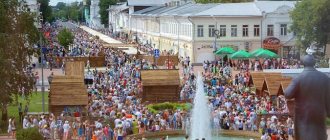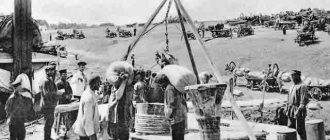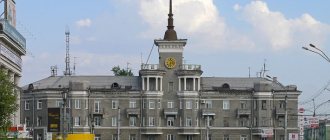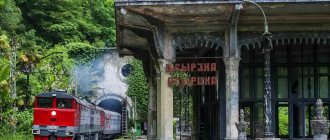Founded: 1683
6 railway directions intersect in Syzran
Sizran
- a Russian city in the Samara region, located on the right bank of the Volga River, at the mouth of the Syzranka River.
Syzran (from Turkic - “flowing from a ravine”) was founded in 1683
like a fortress. Although settlements existed here earlier, a Syzran settlement dating back to approximately the 4th century BC was discovered on the site of the city. The fortress guarded the southern approaches to the Samara Luka, rich in salt pans and fish.
In 1796, the fortress received city status. In the second half of the 19th century, with the advent of the railway network, Syzran became a major transshipment point for goods, an intermediary between water and land routes. The status of an important transport hub of the Samara region has been preserved to this day; 6 railway directions intersect in Syzran.
Cathedral of Our Lady of Kazan In 1830, a cholera epidemic occurred in the city. However, the pestilence suddenly stopped on the autumn feast of the Icon of the Kazan Mother of God. In memory of this, the townspeople annually organize a religious procession. In 1880, the largest bridge across the Volga in Europe at that time was opened near the city.
Many large enterprises were built in Soviet Syzran. Among them: state district power station, Kashpirsky oil shale plant, clothing and furniture factories, food concentrates plant.
The development of the city did not stop even during the Great Patriotic War.
The former estate of the tradesman M. Chernukhin now houses an Exhibition Hall
Modern Syzran is a large industrial city with a developed chemical and oil refining industry.
By decree of the President of the Russian Federation dated September 10, 2022, the city was awarded the title “City of Labor Valor.”
Attractions
The city has many architectural monuments of the 17th-20th centuries: the Spasskaya Tower of the Syzran Kremlin - the same age as the city, the Nativity Cathedral, the holy spring of the Feodorovskaya Mother of God, the Cathedral of the Kazan Mother of God, the building of the city bank.
Interesting
that the symbol of the city is the tomato.
The tomato was brought here several centuries ago from Astrakhan, and the vegetable took root so much that in times of famine Syzran supplied it not only to local residents, but also traded it all the way to the Urals.
The symbol of Syzran is a tomato.
The city has acquired the unspoken nickname “tomato capital”. Since 2001, the Syzran Tomato festival has been held here, culminating in tomato fights among the townspeople.
The city has a population of more than 167 thousand people (2020).
Day of the city
Syzran is celebrated on the first weekend of September.
SIZRAN
SYZRAN, a city in Russia, in the Samara region, the center of the city district of the same name and the Syzran municipal district. Population 165.2 thousand people. (as of 1.1.2021). Located on the right bank of the river. Volga (Saratov Reservoir), at the confluence of the river. Syzranka. Junction of railways and roads.
Story
Sizran. Spasskaya tower of the Kremlin. 1683. Added to 1755.
Founded in 1683 as a fortified city; The construction was led by the Simbirsk governor, Prince. G. A. Kozlovsky. In 1708–1717 as part of the Kazan province, from 1717 in the Astrakhan province. No later than the 1730s. Syzran district was formed. District town of Simbirsk province. Kazan province. (1737–80), Simbirsk province (1780–1928; until 1796 – Simbirsk governorship, in 1924–28 – Ulyanovsk province). Large shopping center, in the 18th century. 3 fairs were held annually. From ser. 19th century the industry developed, ch. arr. flour milling (in the late 19th – early 20th centuries, the 4th city in Russia in terms of grain processing volumes). Railway traffic is open. lines Morshansk - Syzran (1874), Syzran - Farmers (1877), Ruzaevka - Syzran (1898), after which S. turned into a large transshipment center for goods traveling along the Volga and the railway. In 1906 the city was destroyed by fire (over 3.5 thousand buildings burned down), but was soon rebuilt.
Sov. power was established on October 28 (November 10), 1917. During the Civil War of 1917–22, during the performance of the Czechoslovak Corps in 1918, owls. power was overthrown on May 30–31, and on June 17 power passed to the Committee of Members of the Constituent Assembly. On October 3, 1918, the city was occupied by units of the Workers 'and Peasants' Red Army. District (from 1928) and district (1928–30) center of the Middle Volga region (1928–29) and the Middle Volga region (1929–30), then the Middle Volga region (1930–36; in 1935 renamed the Kuibyshev region), from 1936 Kuibyshev region. (since 1991 Samara region). Since 1937, the center of oil production (Syzran oil field, part of the so-called Second Baku). In 1941, during the Great Patriotic War, a number of large industrial enterprises were evacuated to S., a heavy engineering plant (now Tyazhmash) was created on the basis of the Lyudinovo Locomotive Plant, and 11 evacuation hospitals operated in the city. In 1956, the city of Oktyabrsk was separated from the village. In 1961, railway traffic was opened. line Syzran - Tsarevshchina. Since 2005, the center of the urban district and the Syzran municipal district (not included in the district).
Architecture
The city retained its regular layout (1804). In historical the center is dominated by the 5-domed Kazan Cathedral in the Russian-Byzantine style (1866–72, architect A. A. Tamarinsky; bell tower, 1895). On the Kremlin Hill, on the spit of the Syzranka and its tributary the Krymza, the following have been preserved: the Spasskaya Tower of the Kremlin (1683) with a center built on it in 1755. the Savior Not Made by Hands and the tier of the tented bell tower; Cathedral of the Nativity of Christ of the “octagonal on quadrangular” type (1717, restored after a fire in 1741). To the west of the Kremlin Hill, on the banks of the Syzranka, is the Voznesensky Monastery. (1684, closed in 1923, revived in 1996) with c. in honor of the Feodorovskaya Icon of the Mother of God (built in 1738–39 as the Ascension Church, rebuilt in the 1860s), the Ascension Cathedral (1851–53, architect I. A. Benzeman), fraternal (1850) and refectory (1851 ) bodies. To the northeast of the Kremlin Hill there is Bolshaya (now Sovetskaya) Street, where buildings of the 2nd half are located. 19 – beginning 20th centuries: Department of State. Bank of Russia in the spirit of eclecticism (1863), former. district zemstvo assembly (1880s; now Children's Art School), houses of the brotherhood. Volgushevs (1904, architect S.P. Shcherbakov), S.I. Myasnikov (1909), merchant mansions in the Art Nouveau style (P.V. Revyakina, 1908; S.A. Sterlyadkina, 1908–1914, possibly architect Shcherbakov based on sketches by F. O. Shekhtel). Also preserved: Baroque c. Elijah the Prophet (1776), Old Believer church. Exaltation of the Precious Cross of the Lord (1909), Edinoverie ts. St. Nicholas (1913), wooden houses. carvings (including the house of the merchant M.V. Chernukhin - now an exhibition hall of the Museum of Local History).
Centers of science and culture
Higher military aviation Pilot School (branch of the Military Air Academy named after Prof. N. E. Zhukovsky and Yu. A. Gagarin, Voronezh), branches of the Samara state. un-tov - economic. and technical. Centralized library system (1975; includes 2 central libraries and 21 branch libraries). Museums: Local History Museum (founded in 1923, opened in 1925, current name since 1949), Syzran icon painting school. Dramatic Theater named after A. N. Tolstoy (1918). Municipal groups: Russian orchestra. adv. instruments (1972), brass band (1994), chamber choir “Multiple Years” (1995). Intl. brass band festival “Silver Trumpets of the Volga Region” (annually since 1997).
Sport
Among ch. sports arenas - the "Crystal" complex with one. football stadium (2007; 2070 seats), technical stadium. sports (1964), where many are held. competitions (including motorcycle sports). The football club "Syzran-2003" in 2010–19 (disbanded in 2022) played in the PFL (Professional Football League) championship.
Farm
The city-forming enterprises belong to the oil refining, petrochemical and machine-building complexes. Operating: Syzran oil refinery (consisting of; refining capacity 8.5 million tons of crude oil per year; motor fuel, aviation kerosene, bitumen), enterprises of the group - "Tyazhmash" (1941; crushing and grinding, transportation equipment, equipment for nuclear power plants and ground launch complexes) and "Cardan" (1998; cardan shafts for automobile production, etc.), "Syzran-Selmash" (agricultural equipment: sowing and tillage machines, spare parts), "Leader- Tuning" (1997; fiberglass products for the needs of the automotive and electrical industries). Production of sanitary earthenware (“Syzran ceramics”), dairy products, mineral water (“Eridan”), etc. Syzran Thermal Power Plant (1947; over 370 MW; under management).
City population
In 2014, the population of Syzran was 176,000 people, while in 2002 this figure was much higher - 188,000. However, this year, according to statistics, there was some population growth, although this is most likely due to for emigration to Syzran. The Samara region has many less prosperous settlements on its territory, which leads to some people moving to Syzran. And local residents, especially young people, in turn, leave for big cities in the hope of better organizing their lives.
The average age of residents in the city is 40 years. This suggests that the population is aging and, probably, in another few decades there will be practically no young people left here. As for the peculiarities of the worldview of the inhabitants of this city, the influence of the traditions of the bourgeois way of life that reigned here several centuries ago is still felt.
Recommendations
Notes
- ^ a b c
State Committee of the Russian Federation on Statistics.
Committee of the Russian Federation for Standardization, Metrology and Certification. No. OK 019-95 January 1, 1997 “All-Russian classifier of objects of administrative-territorial division. Code 36 242”, Ed. changes No. 278 / 2015 dated January 1, 2016. (State Committee of the Russian Federation on Statistics. Committee of the Russian Federation on Standardization, Metrology and Certification. No. OK 019-95 January 1, 1997 Russian Classification of Administrative Objects (OKATO). Code 36 242
As amended by Amendment No. 278/2015 of January 1, 2016). - ^ a b c d
Charter of the Samara Region - ^ a b c
Federal State Statistics Service of Russia (2011).
“All-Russian Population Census 2010. Volume 1" [All-Russian Population Census 2010, vol. 1]. All-Russian Population Census 2010 [All-Russian Population Census 2010]
(in Russian). Federal State Statistics Service. - "26. The size of the permanent population of the Russian Federation by municipalities as of January 1, 2022.” Federal State Statistics Service. Retrieved January 23, 2022.
- ^ a b c d
Law No. 189-GD - "On the calculation of time." Official Internet portal of legal information
(in Russian). June 3, 2011. Retrieved January 19, 2022. - Post office. Information and computing center of OASU RPO. ( Post office
).
Search for postal facilities ( Search for postal facilities
) (in Russian) - Federal State Statistics Service of Russia (May 21, 2004). “The population of Russia, the constituent entities of the Russian Federation as part of federal districts, urban settlements, urban settlements, settlements, settlements of 3 thousand or more people.” [Population of Russia, its federal districts, federal subjects, districts, urban settlements, rural settlements - administrative centers, rural settlements with a population of more than 3000 people] (XLS). All-Russian Population Census of 2002 [All-Russian Population Census of 2002]
(in Russian). - “All-Union Population Census of 1989. The actual population of the union and autonomous republics, autonomous regions and districts, territories, regions, urban settlements and villages of the sister city of Syzran” (in Russian). Archived from the original on September 25, 2010.
Sources
- Samara Provincial Duma. No. 179-GD December 18, 2006 “Charter of the Samara Region”, as amended. Law No. 6-GD of January 11, 2016 “On amendments to the Charter of the Samara Region.” Entered into force on January 1, 2007. Published: “Volga Commune”, No. 237 (25790), December 20, 2006 (Duma of the Samara Province. No. 179-GD December 18, 2006 Charter of the Samara Region
As amended by the Law dated January 11, 2016 No. 6-GD.
On amendments to the Charter of the Samara Region
. Effective from January 1, 2007). - Samara Provincial Duma. Law No. 189-GD of December 28, 2004 “On granting the status of a city district and a municipal district to municipalities in the Samara region,” as amended. Law No. 23-GD of March 30, 2015 “On the implementation of local self-government in the territory of the Samara urban district of the Samara region.” Came into force after ten days from the date of official publication. Published: “Volga Commune”, No. 247, December 31, 2004 (Duma of the Samara Province. Law of December 28, 2004 No. 189-GD). On assigning the status of urban district and municipal district to municipalities in the Samara region
As amended by Law No. 23-GD of March 30, 2015.
On the implementation of local self-government in the territory of the Samara urban district of the Samara region
. Valid after ten days from the date of official publication.).
Climate and ecology
In order to understand what the climate is like on the territory of the city of Syzran, what region it is, it’s enough to know. The fact is that the local weather conditions do not differ from other settlements located in the temperate continental part of the middle Volga region. Residents of the city have the opportunity to enjoy all four seasons. Summers here are warm and winters are cold. Although there have been more exotic cases - once the city was covered with June snow, and once it was bathed in a February flood.
As for the environmental situation in the city, it is not the most favorable here, because the city of Syzran has many industrial enterprises on its territory. Which region is not important, but the fact that the city is regularly included in the list of the most polluted settlements in Russia is of great importance for local residents. The work of numerous enterprises causes great harm to the important artery of the country - the Volga. About 50,000 tons of various pollutants are released into the city's atmosphere every year.
Coat of arms
The coat of arms of Syzran is presented in the form of a French shield. A black bull is shown in a golden field. It faces the viewer's left. The animal stands on the green firmament. The front right hoof is raised above the ground.
The artistic composition was adopted by resolution of the Syzran City Duma No. 15 of March 27, 2002 (as amended on February 22, 2006). Goes back to the historical version. Included in the State Heraldic Register of the Russian Federation under No. 1389.
Can be reproduced in two versions: with a free part and without it. The first shows a quadrangle adjacent to the upper edge. It reproduces the coat of arms of the Samara region.
Education in Syzran
The Syzran education system is famous for its rich traditions, which were founded during the zemstvo period. There is a gymnasium in the city, the building of which was erected in 1914. In those days it was the first women's gymnasium in the city of Syzran. Which area is also of interest to those who have heard about the local Higher Military Aviation School of Pilots, because this educational institution is the only one in the country that trains pilots for military aviation helicopters.
One of the youngest educational institutions in Syzran is the College of Arts and Culture named after. O. N. Nostsova. It was opened only 43 years ago. The reason for this was the need for further training of graduates of children's music schools, of which there were 3 in the city at that time. In addition, these schools needed professional teaching staff. A lot of effort was made to create this educational institution, partly this was done with money allocated from the city budget, and partly with voluntary donations from concerned citizens. And to everyone’s joy, on September 1, 1972, the Music College opened its doors to its first students who wanted to study such specialties as “Choral Conducting,” “Piano,” “Music Theory,” and “Folk Instruments.” Over time, the list expanded, and the theoretical and practical base of the institution became richer. Today, many graduates of music schools are interested in what region Syzran is located in, precisely in order to study at the local college.
Transport connection
The transport links of the city of Syzran are at a fairly high level. What area this is, many do not know, and because of such developed transport links they believe that it is an independent city. The railway passes through the territory of the settlement in six directions and connects the city with all CIS countries. It is worth noting that the local railway station can easily be confused with the capital one, it is located at such a high level. It was built about 150 years ago and recently restored. Inside the station, in addition to everything necessary for travelers, there is also a small museum, which displays photographs, original items and other elements of the ancient interior. In front of the main entrance of the station you can see two statues - a girl and a young man showing her the city.
In addition, a federal highway passes through the city, which ensures good bus connections with various cities of Russia. The city is also crossed by the Volga River Route.
